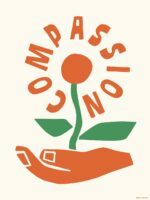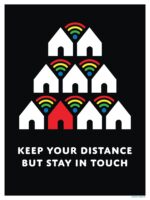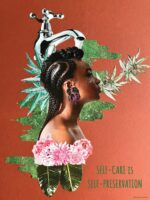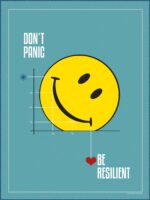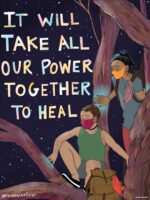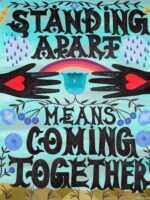Voices of Wellbeing | Nadine Kaslow Voices of Wellbeing | Nadine Kaslow
“I use the Arts as a way to cope, to heal, and to flourish”
In this captivating episode of “Voices of Wellbeing,” join American psychologist Nadine Kaslow as she explores the transformative power of integrating dance and psychology to heal trauma, intergenerational trauma, and vicarious traumatization. Discover how Nadine, an Emory University professor, provides essential support to healthcare workers during the pandemic, finding a delicate balance between self-care and attending to the inner world.
Explore the profound impact of “Healing Through Arts” as Nadine utilizes art as a therapeutic tool to address intergenerational trauma stemming from experiences such as slavery, racism, and child abuse. Witness the power of artistic expression in helping individuals navigate their healing journey while fostering connections with others to bridge the gap between reality and a more just and equitable world.
This Funders Group Wants Philanthropy to Take the Lead on Nonprofit Worker Wellbeing This Funders Group Wants Philanthropy to Take the Lead on Nonprofit Worker Wellbeing

Words:
Wendy Paris
Journalist
Changemakers are burned out, as we’ve been hearing for the past few years. Now, leaders from a dozen philanthropies are tyring to make a difference through the Funders & Wellbeing Group (FWG), a learing collaborative launched in 20222 with the aim of increasing members’ own understanding of the connection between effective social change and the welfare of changemakers — and pushing philanthropy as a whole to take the concept of wellbeing more seriously.
The FWG is a program of the Wellbeing Project, a global nonprofit founded in 2015 by Ashoka Fellow Aaron Pereira in reaction to his own burnout. The Wellbeing Project has a staff of 35 and works to “normalize and create access to wellbeing in the social change sector,” according to its website. The project is focused not only on the West but also the Global South, where the toll on those in the helping professions can be even greater and access to support even more scarce.
Twelve organizations joined the first two-year cohort, with at least two participants from each group coming to meetings, including one from senior leadership. The current members include the group’s main funder, Robert H.N. Ho Family Foundation Global, as well as the Ford Foundation, Asian Venture Philanthropy Network, Laudes Foundation, Segal Family Foundation, Skoll Foundation, Imaginable Futures, Camelback Ventures, the Hewlett Foundation, Alana, the SHM Foundation and Global Fund for Children.
The FWG is a small program in the Wellbeing Project’s overall scope, operating on initial funding of about $70,000 from Robert H.N. Ho Family Foundation Global, and an annual fee of 5,000 euros per participant. Still, its creation points to philanthropy’s growing interest in bolstering the welfare of those working to make the world a better place.
Funders play an important role in the wellbeing of organizers and nonprofit workers, of course, given that philanthropic dollars often cover salaries and benefits. And a handful of funders, including the Durfee Foundation, support wellbeing-focused initiatives such as employee sabbaticals and other forms of worker care. The nonprofit Fund the People is also advocating for philanthropy to prioritize nonprofit workers’ wellbeing.
Still, the importance of wellbeing more generally remains largely overlooked, said Dana Preston, the Wellbeing Project’s development and partnership lead. “Wellbeing is underfunded because it’s not considered essential. It’s considered a ‘nice to have,’ ‘woo-woo,’ a luxury, hippy-dippy. We still have a way to go for wellbeing to be recognized as essential to lasting change.”
Putting wellbeing on the agenda
Preston said she runs up against a generalized dismissal of wellbeing in her development role at the project. One way she argues for its importance is by having funders experience it themselves. In her job at the Wellbeing Project, she does this by arranging outings, such a week-long “inner work” retreat. The Funders & Wellbeing Group is another such experience. “This is strategic for us,” she said. “If we can work with philanthropy to understand that wellbeing is essential, that will unlock funding for it and create momentum for changemakers.”
As of December 2022, the group had met four times and established goals, including implementing an action plan within their own organizations and collaborating with other group participants on the larger project of shifting philanthropic norms.
Bad habits take time to die
The FWG is also part of philanthropy’s critique of its own practices that replicate the negative power dynamics of capitalism. These include things like demanding, competitive RFP processes, exhaustive reporting requirements for even small grants, and chronic underfunding of nonprofits — all of which can compromise the wellbeing of nonprofit leaders, employees and the communities they serve, said Jessamyn Shams-Lau, co-chair of the FWG.
Moving beyond these practices is of immediate, practical importance. “We see a lot of nonprofit leaders burn out and leave. This is not only ethically wrong, but also illogical from the perspective of longevity,” said Shams-Lau. “Their ability to stay engaged in this work means we will not lose the knowledge and wisdom they built up over the years.”
I’m Feeling Optimistic About 2023, Thanks to Advice From The Dalai Lama’s Doctor I’m Feeling Optimistic About 2023, Thanks to Advice From The Dalai Lama’s Doctor

Words:
Molly Longman
Journalist
I’ll say it — I’m feeling cautiously optimistic about 2023. Let lightning strike if it will.
I feel this way, seemingly against the odds. I’m one of those masochists who reads the news faithfully each morning, taking in the passing of increasingly draconian laws, the “tripledemic,” mass shootings, climate change… and, don’t get me started on the capitalistic voyeurism-nightmare that was #christmashaul TikTok. I could — and have — written pages on these issues individually, so grouping them together almost seems flippant. But we live in a world where we’re constantly forced to skip from one tragedy to the next, like a rock on a lake that happens to be polluted, on fire, and full of genetically altered one-eyed fish.
Okay, okay… I know that doesn’t sound optimistic, but I’m feeling that way in spite of all of these things, even with the knowledge that 2023 will bring its own set of challenges. I’ve been doing a lot of thinking about a series of inspiring conversations I had back in 2022 with Barry Kerzin, MD, who happens to be the Dalai Lama’s physician. We spoke at The Wellbeing Summit for Social Change, and I watched him give a talk and workshop. By the end of the week, we were discussing politics and the concept of hell over tea.
Dr. Kerzin isn’t just a nice guy and a famous physician, but a Buddhist monk, an author, a professor, a nonprofit-founder, and the creator of the meditation app AIMIcare. He gets a lot done — and not just because he wears sneakers under his monastic robes. Dr. Kerzin is fueled, in part, because he’s learned through grief, training, and time to have a lot of compassion for people. And that mindset of loving-kindness has led to his pursuits. A lot of people (okay, me!) might initially roll their eyes at the phrase “loving-kindness” — which means putting out positive energy toward yourself and others, often through meditation. But after talking to Dr. Kerzin, it’s not hard not to feel like there might be something to it. In fact, my conversations with him resonated so much, I came back to the tapes of them while thinking about what I wanted to accomplish in 2023. I was especially struck by the way Dr. Kerzin had gone through difficult times — he lost his mother at a young age, and then his wife — and yet found a path that helped him stay steady and make the world a better, kinder place.
There are several nuggets from our talks that I’m taking into the new year with me, and I’ve laid them out here. Hopefully, they’ll speak to you too… and maybe even make you feel optimistic.
Start with self-compassion
The idea of self-compassion can seem antithetical to the whole “I’ll be better in 2023” shtick, which is why I’m starting with it. Whether your plan this year is to move your body more or improve time management, it’s difficult not to be hard on yourself the first time you skip a workout or forsake your to-do list. But negative self-talk can impact us in big ways, and even subconsciously affect our ability to be tolerant of others.
You can challenge the harsh voice inside your head by just noticing when it’s putting you down. Say, if you catch the voice telling you that you’re going to completely fail at all your New Year’s resolutions just because you had one setback. Just recognizing that you’re having these thoughts is a great first step on the path to self-compassion. Then, it’s a matter of redirecting those thoughts to more warmhearted ones (maybe think of an affirmation you’d give to your bestie if they were in the same situation, and write that down or remember it).
Dr. Kerzin also recommends working hard to notice if the negative voices in your head are really echoes of your past. If someone has told you, directly or indirectly, that you aren’t smart or attractive, it’s easy “to internalize those things,” he says. “And the more we do that, we make them our own. It becomes like our own voice saying those things, even though it didn’t start out that way. It was somebody else putting us down. We need to recognize that this is not ours. That gives us permission to slowly just throw that stuff out. Don’t buy into it.”
Another easy way to practice self-compassion: “Doing things we enjoy and that are meaningful to us — do them!” Dr. Kerzin says. “It’s okay, whatever it is.”
Be kind to others, too
Being nice to ourselves lays the groundwork for how we treat others. “Having self-compassion — giving more kindness and gentleness to ourselves — is a foundation,” Dr. Kerzin says. But, “if we stop at only being compassionate to ourselves, that’s when it can become selfish. The more we have compassion for ourselves, the more we can help others, engage with, and listen to them… In the same way that we’re getting in touch with our own pain, when we’re with someone and they are in pain, we can better figure out what we can do to help.”
We can put kindness into play in 2023 in myriad ways — just listening to a friend when they’re upset, volunteering, donating, forgiving someone, or giving a colleague the benefit of the doubt.
And, as with the circle of life, these acts of compassion towards others also end up being in service of ourselves. “Helping others is actually a wonderful way to help ourselves,” Dr. Kerzin says. “We feel good when helping others.” In other words: “Compassion is a win-win.”
Now, it’s easier to be compassionate to some than to others. There are people who get under our skin — and those we don’t even like. When you come across these folks, Dr. Kerzin says it can help your mindset to “make a distinction between the actor and the action. People have to be held accountable for their actions, but you can still have compassion for the person.” This is because, in Dr. Kerzin’s view, if someone is doing wrong, they’ll have to pay for their harmful actions in the future, one way or another. As Taylor Swift has said, “karma’s on your scent like a bounty hunter.”
Develop an inner safe space, even when the world outside is crazy
I mentioned my love of the news — there’s a lot of upsetting stuff screaming up at us from our phone screens. And immersing ourselves too much in such events can make us feel powerless. So much is still out of our control, no matter how much we protest, recycle, and call our Congresspeople.
That’s why it’s helpful to cultivate a space where you can go to find peace despite any external chaos that’s coming from your phone, community, coworkers, or even your friends and family. You can do this through mindfulness, meditation, or journaling. “There are various ways we can go inside in the present moment and observe what’s happening,” Dr. Kerzin says. “Ask yourself: What am I thinking? What am I feeling? What are my emotions? What’s my mood? What are my attitudes?… Rather than reacting, we are just observing. The more we take this approach, slowly with time, we’re less influenced by external affairs.”
Maybe you’re thinking: I have tried meditation and I’m not a fan. But it doesn’t have to be a formal “sit down and count your breath” kind of ordeal. It could be just taking a stroll in the park and noticing your body move. You could also try noticing the sounds and tactile feeling of doing the dishes, something my favorite meditation app Healthy Minds recommended to me. Or going to yoga or a concert or sitting in a church, mosque, or temple, and noticing how your five senses are responding.
“If we develop this practice to go inward and observe without reacting or judging, our inner life can let us develop a home; that home is in our hearts,” Dr. Kerzin continues, placing his hand over his chest. “It’s inside. And it’s something we can always return to, regardless of the climate catastrophe and the pandemics. It gives us a place of safety. A place of joy. And that’s something we can reach in the face of external calamities.”
That’s not to say we should stay in and ignore the pivotal issues around us. Knowing we have this safe place to come home to can give us the strength to turn outward again and fight for the causes we care about. “Having this home in our hearts gives us the strength, inspiration, and courage to go out and fight for what is right the next day,” Dr. Kerzin says. “Of course, ‘fight’ with love and compassion, ‘tough love.’”
Consider your “purpose” — not your goals
“When I was young — six, seven or so — there were two questions that were coming up for me regularly,” Dr. Kerzin says. “I’d ask, Who am I? and What am I doing here? These questions arose spontaneously. My life has been a lot about answering those questions,” Dr. Kerzin says. “I’ve come to the conclusion — it’s still an open question — but what I’ve come to is my purpose is to serve and help others.”
Having a purpose, whatever it may be, is different from having a “goal.” “Goals are temporary but a purpose is more meaningful,” Dr. Kerzin says. Now, having goals is by no means a bad thing, but they tend to be specific and time-related — I want to start volunteering or I’m going to run a half marathon this year — but “the purpose we’re talking about here is a deeper one underlying what’s meaningful and important about your whole life.” Dr. Kerzin prefers the “purpose” framing because he believes too much goal-setting can take you away from the present moment — meaning you can forget to appreciate the beauty of where you are right now.
If you’re not sure of your purpose, you can journal about the very questions Dr. Kerzin was asking himself as a kid: Who am I? What am I doing here? Once you know your purpose, it’s also important to ask: what tangible steps — both long- and short-term — can I take to achieve this?
Don’t put too much pressure on your purpose — it could be ever-changing and as simple as “make the lives of those I interact with a little better” or “do my part to raise awareness for a cause I care about.” When in doubt, “follow your heart,” Dr. Kerzin says.
Take the “middle way”
The “middle way,” is a Buddhist philosophy that involves steering away from extremes — from high highs and low lows in life. Dr. Kerzin happened to write a book about it. These days, many of us spend a lot of time creating highlight reels of our best lives — all the schnazzy shit we got for Christmas, for example. Or we’re venting about negative things to our friends and followers. This culture can make it harder to follow the Buddhist ideology, but not impossible.
“The middle way has different contexts,” Dr. Kerzin says. “It means on the one hand, in terms of our behavior, not to get too caught up with luxury. If we’re treated to something or buy something nice for ourselves, that’s fine, but don’t get too attached to it. Realize it’s not the only way to find happiness. It’s more of a way to find pleasure. But happiness is something in addition to pleasure, and it’s more lasting — subtler, more balanced and centered. But it’s also inside ourselves in our inner home.”
This comes back to having that “home” inside our hearts and minds — that concept helps us be a little less influenced by external trappings.
“Remember, pleasure comes from our senses: That painting is beautiful or this food is over the top,” Dr. Kerzin adds. “These are beautiful things. But they don’t last. They come. They go. If we don’t have them, sometimes we get pretty blown out of the water. We get depressed. But if we’ve cultivated this safety — this warm kindness, this love inside ourselves — we can develop this sense of a middle way, finding inner peace of mind.”
Don’t take yourself too seriously
Having a sense of humor makes life easier. And not taking yourself too seriously helps you avoid both acting arrogant and telling yourself you’re not enough. And if you do notice you’re freaking out over something small — or you’re feeling superior to others — Dr. Kerzin knows the best medicine: “Have a good laugh at yourself and move on.”
Last year, I left my conversations with Dr. Kerzin — and the uplifting Wellbeing Summit in general — feeling re-energized. I told myself I’d do a mindfulness meditation daily and really focus on the idea of compassion. I felt like I had a new lease on life. But, not long after the summit, the real world came crashing in like a tsunami and I felt like I was drowning in those dirty waters I mentioned before. Instead of morning mindfulness sessions, I’d jump out of bed and head straight to my desk, where I’d hunch over my laptop for hours. I was extremely hard on myself — I felt I was never doing enough. I wasn’t practicing compassion towards myself and, sometimes, towards others.
It’s true, I spent a good part of 2022 doing the opposite of everything I’d learned at the summit and from Dr. Kerzin. But there were also times — not every day, but often enough — in which I did come back to these ideas of compassion, mindfulness, and the middle way. I certainly was not always consistent, but I did make progress. I’m acknowledging those baby steps as an act of self-compassion.
So, I’m kicking off 2023 with my purpose in mind, hoping that I’ll grow in these concepts even more. That’s why I’m feeling good about it. And if the year is all uphill from here, I’ll employ another one of Dr. Kerzin’s lessons: I’ll laugh at myself for leading this story with the word “optimistic.”


David Simas
Managing Director, Research and Impact, Emerson Collective
David Simas is the Managing Director of Research and Impact at Emerson Collective, where he works to develop in-depth research projects and distributes findings and analysis in service of Emerson’s priorities including democracy, immigration, education, and climate.
A native of Taunton, Massachusetts, David was appointed Deputy Chief of Staff to Massachusetts Governor Deval Patrick in 2007. He then joined President Obama’s administration in 2009 as a Deputy Assistant to the President, working with senior advisors David Axelrod and David Plouffe. In 2012, he served as Director of Opinion Research for President Obama’s reelection campaign. Following the reelection, Mr. Simas returned to the White House as Assistant to the President and Director of the Office of Political Strategy and Outreach. In 2016, President Obama selected Mr. Simas to serve as Chief Executive Officer of the Obama Foundation. Mr. Simas holds a B.A. in political science from Stonehill College and a J.D. from Boston College Law School. He is the son of two Portuguese immigrants and lives in Los Angeles with his wife, Shauna, and their two daughters.
Connect with the Emerson Collective on social media:
Learn more from David Simas Learn more from David Simas

Father Timothy Radcliffe
Priest, honorary Oxford University fellow and Author
Timothy Radcliffe OP joined the English Province of the Dominican Order in 1965, and was ordained a priest in 1971. He studied in Oxford University, and Paris. He was a chaplain to the University of London in 1974 – 76, before returning to Oxford, where he taught for twelve years. In 1992 he was elected Master of the Order of Preachers (the Dominicans), finishing his term in 2001. He is now an itinerant preacher and lecturer, based in, Oxford, spending half the year traveling until covid! He was a Trustee of the Catholic Agency for Overseas Development for fourteen years and is a patron of ‘Embrace the Middle East’.
He is an Honorary Fellow of St John’s College, Oxford, and Doctor of Divinity hon. causa of Oxford University, and also from Fribourg University and ten other universities in Italy, France and the United States. He has written several books, which have been translated into 24 languages, the most of which is ‘Alive in God: a Christian imagination’ (2019). He was awarded the Michael Ramsey Prize for theological writing in 2007. He is a Sarum Canon of Salisbury Cathedral and has the freedom of the city of London.

Dr Rukudzo Mwamuka
Psychiatrist
Dr Rukudzo Mwamuka is a psychiatrist living and working in Zimbabwe. For the past 6 years, she has been providing clinical care to patients from marginalised communities at the referral psychiatric units in the capital city of Harare. Her experience in working with patients and understanding their challenge to access to mental health services ignited her interest in community mental health interventions. To pursue her interest, Rukudzo joined the Friendship Bench, an organisation that trains community health care workers to provide Cognitive behavioural Therapy with emphasis on Problem Solving Therapy, activity scheduling and behavioural activation.
In her role as the Clinical Programs Manager and member of the organisation’s Senior Leadership Team, Rukudzo provides oversight and strategy for the Implementation teams. She is currently focusing on ensuring fidelity of the program as it scales across the country with support from the Ministry of Health and the World Health Organisation under the special initiative for mental health.She is a member of the Catalyst 2030 movement.
Rukudzo holds a medical degree (MBCHB) from the University of Zimbabwe and a Master of Medicine degree (Psychiatry) from the same university and she continues to tutor undergraduate medical students from the university’s mental health unit.

Gabriela Gandel
Board Director, Impact Hub
As an experienced leader of innovative global organisations, organisational and personal development consultant and experiential learning designer Gabriela is committed to building organisations and systems that enable people and planet to thrive and meaningful visions to get accomplished.
She spent her last 15 years working as an executive manager with a mix of not for profit and for profit global organisations spanning over 50 countries around the world. As an executive manager she worked for AIESEC International and Romania, Future Considerations and Impact Hub global. As a consultant her clients included HSBC, KPMG, BP, TATE Britain and 10 key art galleries in England, ProVita Romania, RoPot, Human Invest. Throughout her career Gabriela had coaching engagements with over 40+ leaders. This all was fun and makes up for her more than 5 passports used up to date.
Currently she happily serves the Impact Hub network as a Board Director, helping build strategic partnerships and policy influencing initiatives. And with this pursuing her stand of a connected humanity acting as a power for good.
Connect with Gabriela Gandel on social media :
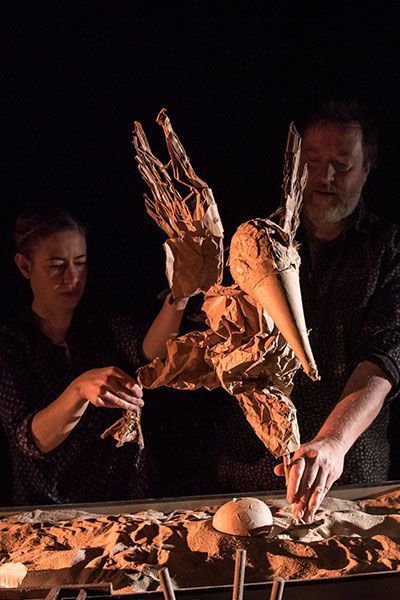
Birdheart
Theatre Production
Julian Crouch and Saskia Lane’s BIRDHEART – An intimate and stunning chamber piece of animated theatre with a sheet of brown paper and a box of sand. A show about transformation, loneliness, and the urge to fly, BIRDHEART holds a hand-mirror up to humanity and offers it a chair. Through a series of animated images built in front of the audiences’ eyes BIRDHEART creates something achingly beautiful from the humblest of beginnings.
The show tells a story of man’s relationship to the world. An egg lies on the sand, and from the egg is born a large sheet of crumpled brown paper. The sheet of paper pulls elements up out of the sand; different hands, feet, heads. Sometimes the paper opens outwards and shadow images are projected in the heart of the paper figure. The figure dreams of a bird. Eventually, the sheet of paper transforms itself into a large paper bird, lays an egg, and flies off.
The onstage creation of something from nothing is at the very heart of the piece. The brown paper suggests the soul and emotion of the metamorphosing puppet, and the objects that are pulled from the sand give identity and story to the shifting characters. The egg reminds us of where we all come from. The uncontrollable nature of the material means that each show is different and grows organically in the moment.
Birdheart features a recorded soundtrack of double bass and banjo composed and performed by Saskia Lane and Julian Crouch.

Janet Cardiff & George Bures Miller
Sound Installation Artists
Canadian artists Janet Cardiff and George Bures Miller live and work in British Columbia, Canada. The artists are internationally recognized for their immersive multimedia sound installations and their audio/video walks. They have created recent video walks at the Walt Disney Concert Hall in Los Angeles (2019), and for the Fruitmarket Gallery in Edinburgh (2019). Over the last few years, Janet and George have shown at the Museum of Modern Art in New York (2019) Museum of Contemporary Art in Monterrey, Mexico (2019); Oude Kerk, Amsterdam (2018); 21st Century Museum, Kanazawa, Japan (2017); Fondation Louis Vuitton, Paris (2017); ARoS Aarhus Art Museum, Denmark (2015); Museo Nacional Centro de Arte Reina Sofía, Madrid (2015); Menil Collection, Houston (2015); 19th Biennale of Sydney (2014); the Cloisters, Metropolitan Museum of Art, New York (2013); and Documents 13, Kassel (2012). In 2020 they were awarded the Wilhelm Lehmbruck prize for sculpture and in 2011 they received Germany’s Käthe Kollwitz Prize. In 2001, Cardiff and Miller represented Canada at the 49th Venice Biennale , for which they received the Premio Speciale and the Benesse Prize.
Click here to learn more about Janet Cardiff & George Bures Miller.
Read on for an exclusive Q&A with Janet Cardiff & George Bures Miller ahead of the Summit:
What does wellbeing mean to you?
Well-being is a state of mind that is essential to the healthy functioning of our whole body. I find that my own sense of well being is connected not only with treating my body and mind well but also by the action of creativity. Through playing in the studio I’m able to feel fuller and happier.
Why are you looking forward to being part of The Wellbeing Summit?
When creating monumental sculpture, I consider how our architectural surroundings influence and affect our state of mind.
How does your work connect to wellbeing?
We are creating an artwork that uses the concept of “voice toning”, a therapeutic practice where the natural vibrations of voices help to contribute to healing and well being. Our piece will play back a collection of “voice tones” creating a calming listening environment. Additionally, we will invite audience members to participate in the making of the piece over the course of the conference by adding their own “voice toning” that will then be mixed into the piece. We believe that creating as well as experiencing artworks contributes to wellbeing. In this piece we are excited that each audience member will be able to both experience the therapeutic elements of the artwork but also contribute their own voice to the wellbeing of others in the community.
Connect with Janet Cardiff & George Bures Miller on social media :











